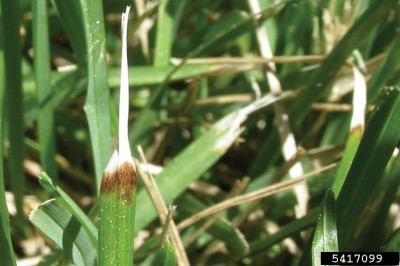






Lawns stretch out across suburbia like an endless grass sea, broken only by the occasional tree or flower patch, thanks to careful maintenance by an army of homeowners. When your lawn is healthy and green, it almost melts into the background, but as soon as brown, brittle grass appears, your lawn stands out like a neon sign. Blighted turf symptoms are common lawn troubles, often caused by turf stress and fungal diseases like ascochyta leaf blight.
Ascochyta leaf blight on lawns is caused by an infection by the fungal pathogen Ascochyta spp. Many grasses are susceptible, but Kentucky bluegrass, tall fescue and perennial ryegrass are the most common victims. Ascochyta leaf blight comes on quickly, causing large brown or bleached patches in lawns when the weather is quickly alternating between very wet and very dry, but the exact environmental trigger is unknown.
You can positively identify an ascochyta leaf blight infection by examining damaged grass blades with a hand magnifying glass. Look for minute yellow to dark brown, flask-shaped fruiting bodies scattered on discolored grass blades. If you find them, don’t panic, grass with leaf blight is rarely seriously injured since the fungus doesn’t attack the crowns or roots.
Because aschochyta blight is so transient, it’s difficult to time fungicidal treatments properly, but a good general care program can go a long way to helping your grass recover. Dethatch and aerate your lawn each year in the fall to increase water penetration and reduce hiding spots for fungal spores. Even irrigation throughout the growing season is recommended for grasses of all types, but don’t allow your lawn to get soggy or leave grasses in standing water.
Frequent, close mowing can increase the visibility of grass with leaf blight, so sharpen your blades and keep your grass at a height of 2 ½ to 3 inches. Reducing mowing frequency will give grass more time to heal between cuttings, reducing the opportunities for pathogens to enter the blades. Applying a balanced fertilizer can help strengthen grass, but avoid large applications of nitrogen, especially in the spring – excessive nitrogen increases the growth of new, succulent foliage that will require more frequent cutting.
Copyright © www.100flowers.win Botanic Garden All Rights Reserved